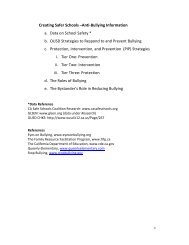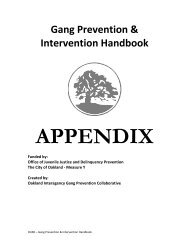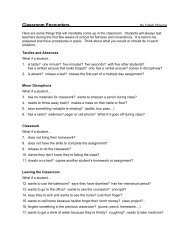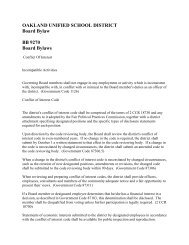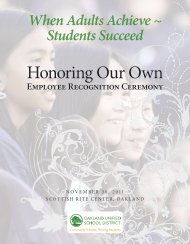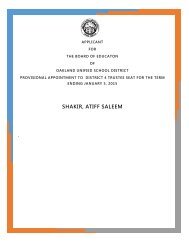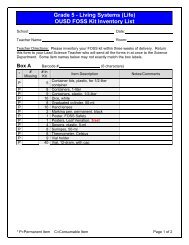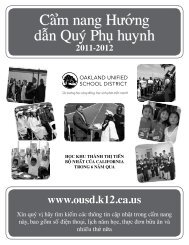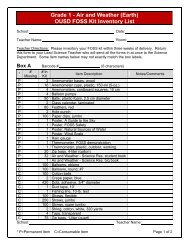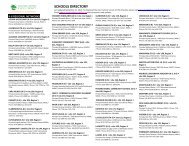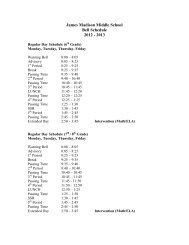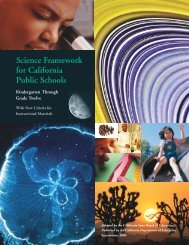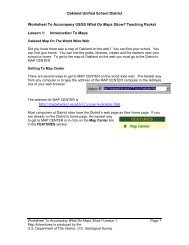Oakland Unified School District Case Study
Oakland Unified School District Case Study
Oakland Unified School District Case Study
Create successful ePaper yourself
Turn your PDF publications into a flip-book with our unique Google optimized e-Paper software.
6. New Leaders for New <strong>School</strong>s is a non-profit organization that partners with districts to recruit, train,<br />
certify, and place principals. One part of the principal training programs focus on developing standardsbased<br />
assessments.<br />
7. Math program used by the Long Beach <strong>School</strong> <strong>District</strong>. The Si Swun Lesson design is as follows: 1) spiral<br />
problem of the day (from old content that wasn’t mastered); 2) stating/writing of the lesson’s objective;<br />
3) writing new vocabulary in math journal; 4) direct instruction; 5) structured guided practice (students<br />
work in groups to solve problems); 6) presentations (students randomly selected to solve a problem/<br />
explain strategies on board).<br />
8. The new small schools were among the first to pilot many of the new assessment, such as Edison/<br />
Tungsten ELA assessments, Action Learning, Si Swun, and New Leaders assessments now being offered<br />
to more schools district-wide.<br />
9. Associations of Community Organizations for Reform Now (ACORN) is the grassroots community<br />
organization that led a struggle to improve the neighborhood, including a new elementary school for<br />
neighborhood residents.<br />
10. New <strong>School</strong> Development Group Matrix, OUSD Leadership Matrix.<br />
11. Johnson, C. (2005, September 2). Ex-dropout, now school principal. San Francisco Chronicle.<br />
12. The multi-track, year-round schedule used by the large neighborhood school to alleviate overcrowding<br />
necessitated teachers packing up their rooms and then unpacking every couple of months. In a year-round<br />
multi-track school students were divided into four tracks with only three tracks, attending the school at<br />
any one time.<br />
13. In reciprocal teaching, students are trained to have group leadership roles that include “Monitoring/<br />
Clarifying,” “Predicting,” and “Summarizing.” Students are able to take academic leadership roles during<br />
discussions, and therefore develop more ownership of reading goals.<br />
14. AWE varies its ELA program by grade levels as well. In grades K-3, students read text that is at or<br />
slightly above their reading level, and then they receive consistent feedback and instruction according<br />
to their different reading needs. This is done primarily through guided reading methods. In Grades 4-5,<br />
reciprocal teaching is used more widely.<br />
15. Students requiring extra support to reach mastery receive additional time during the after-school<br />
Extended Learning Program.<br />
16. AWE curriculum flexibility application for 2008-09.<br />
17. Accelerated Reader is a computer-based program in which students read a book and then take a test on<br />
a computer to determine their level of understanding of the text. Students are then awarded points based<br />
on their performance on the test and the difficulty of the text.<br />
18. Backwards mapping begins with teachers identifying the desired student results and the assessments used<br />
to measure learning. Teachers then implement lessons designed with the end product and assessments in<br />
mind.<br />
22<br />
<strong>School</strong> Redesign Network at Stanford University



